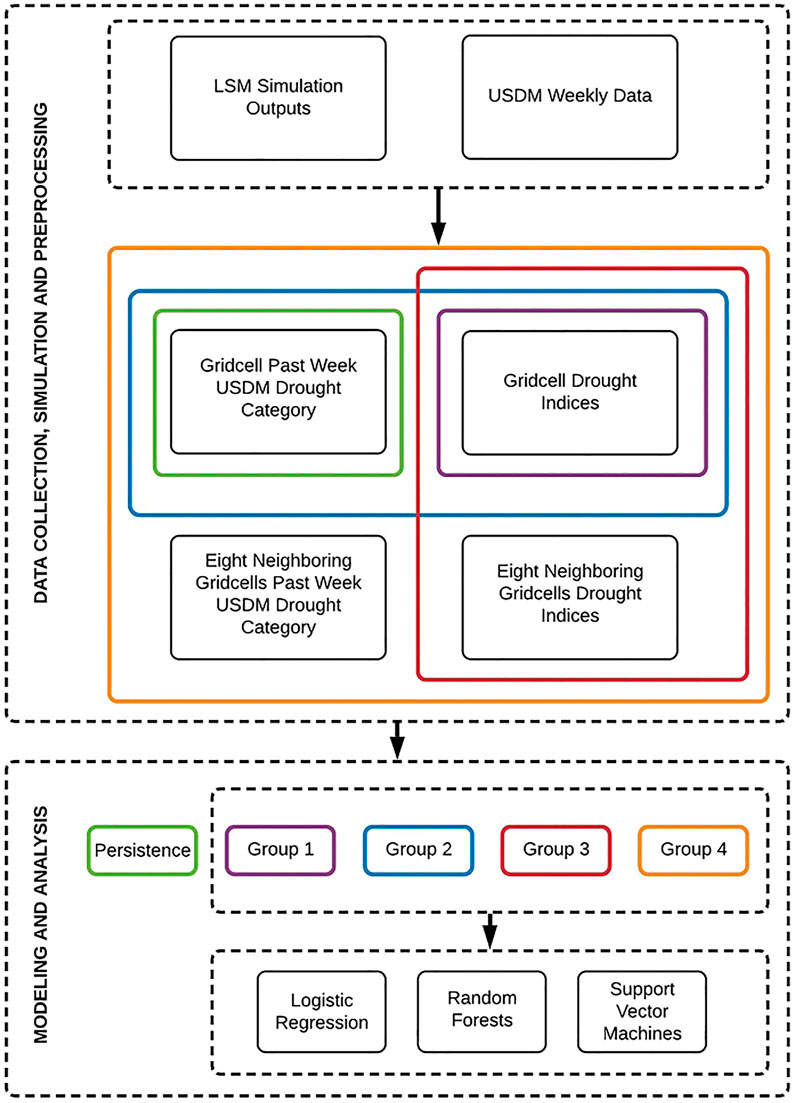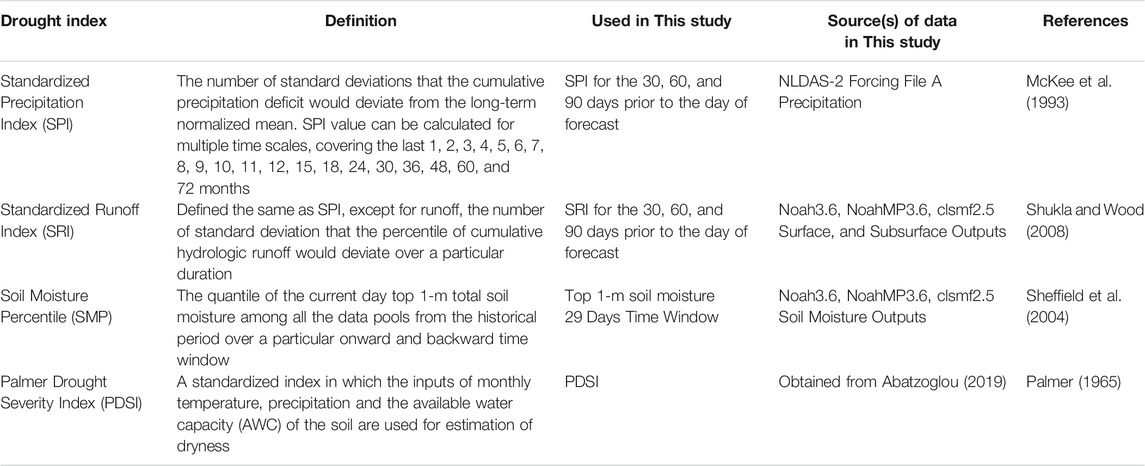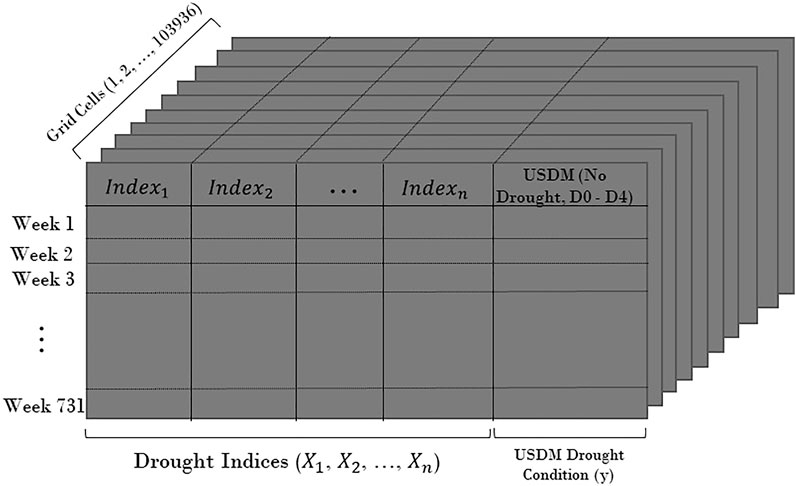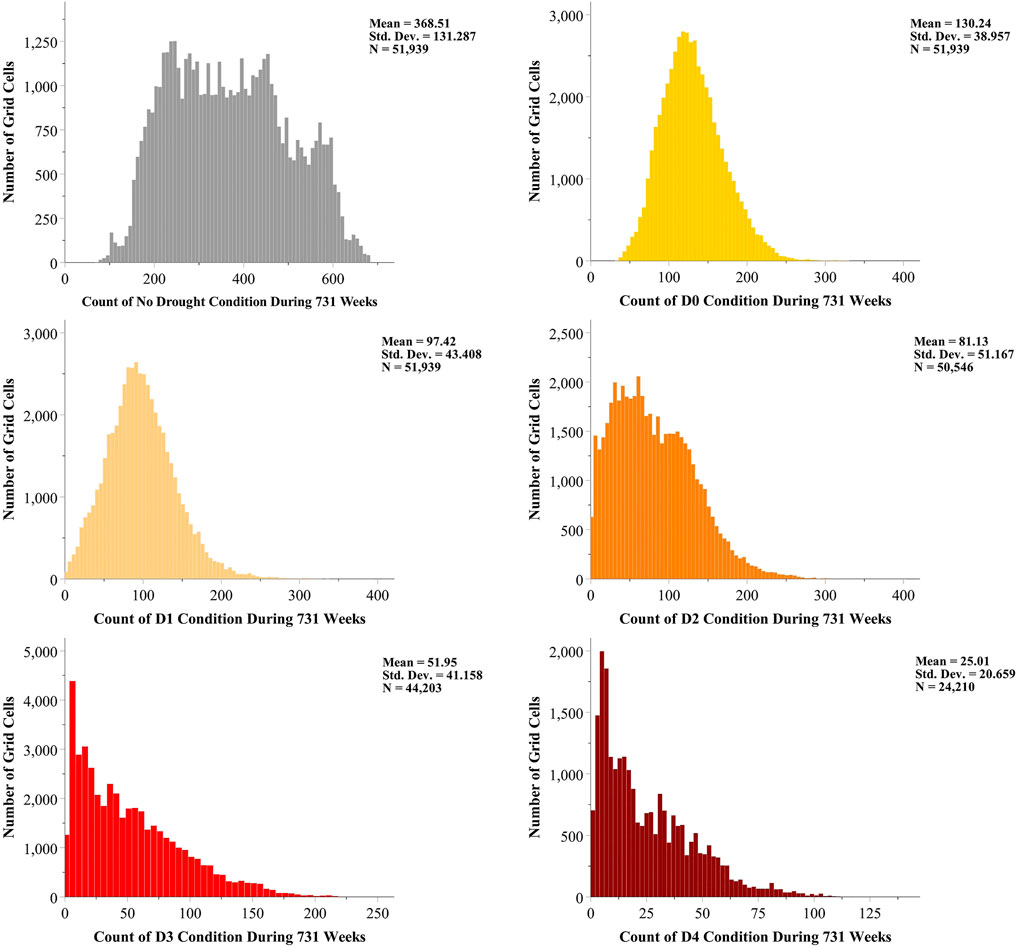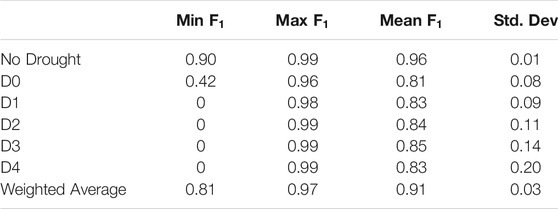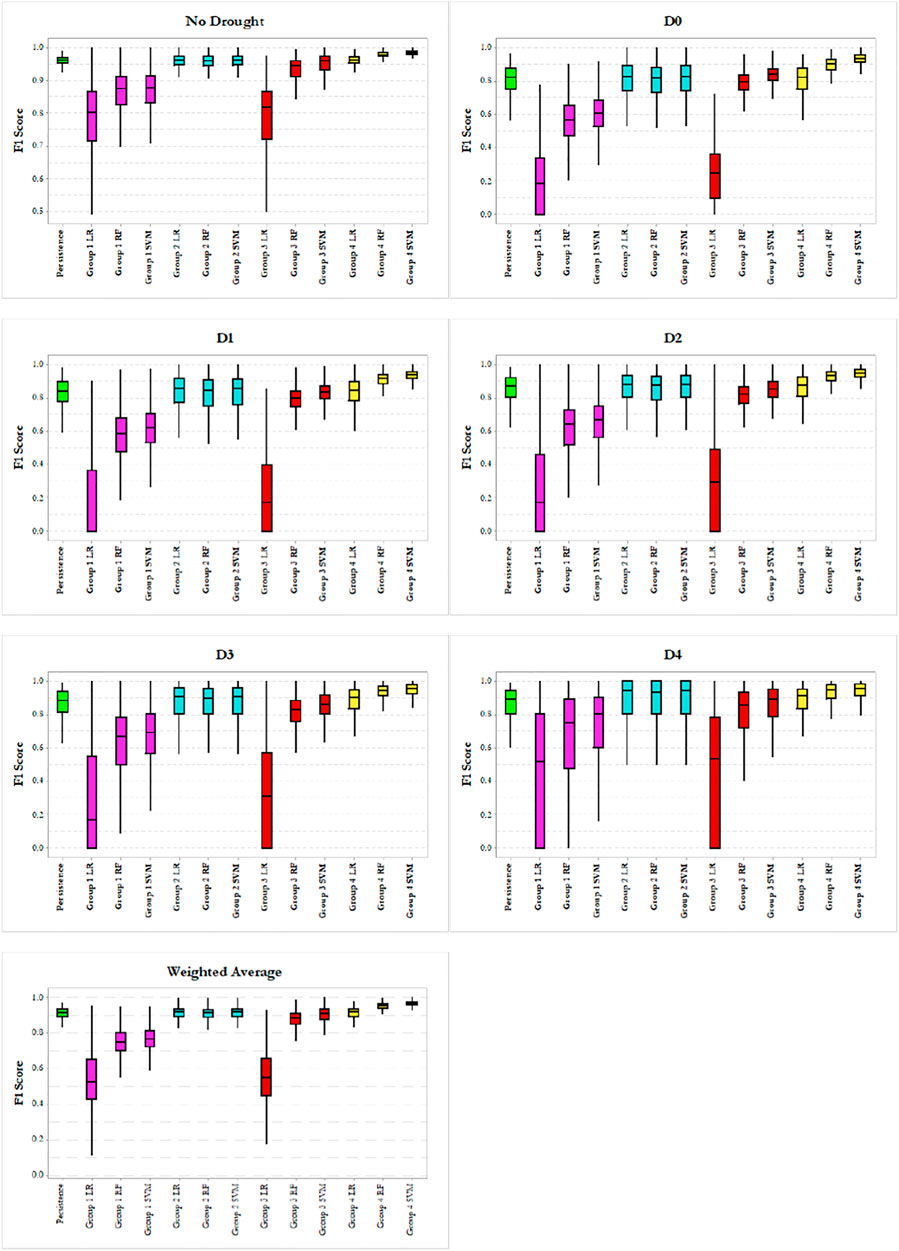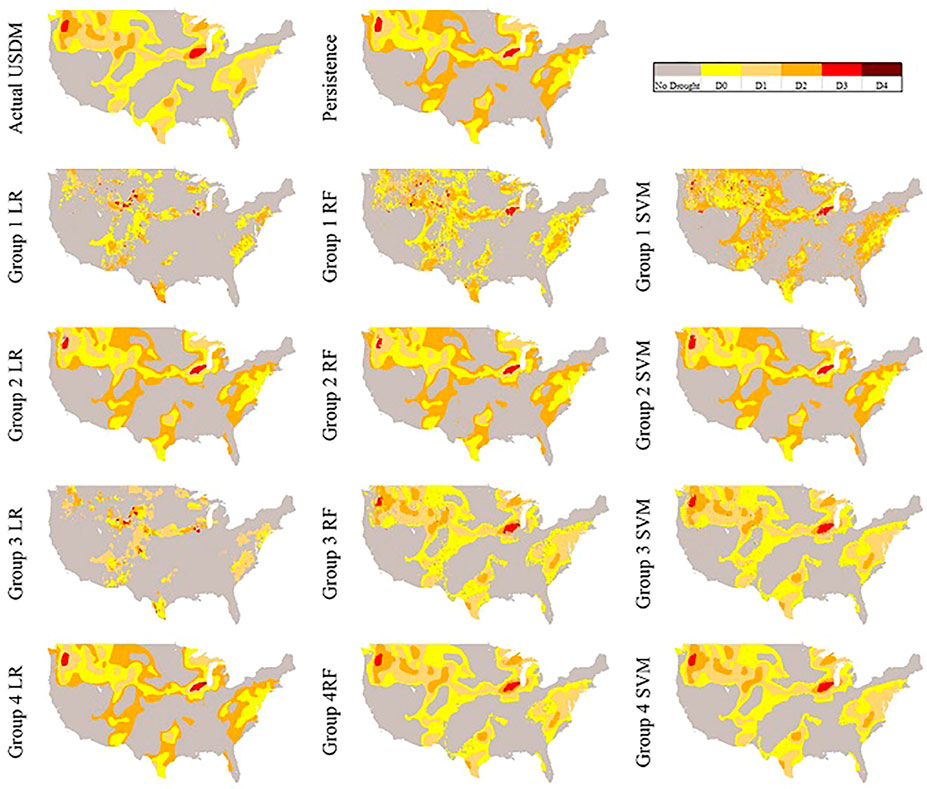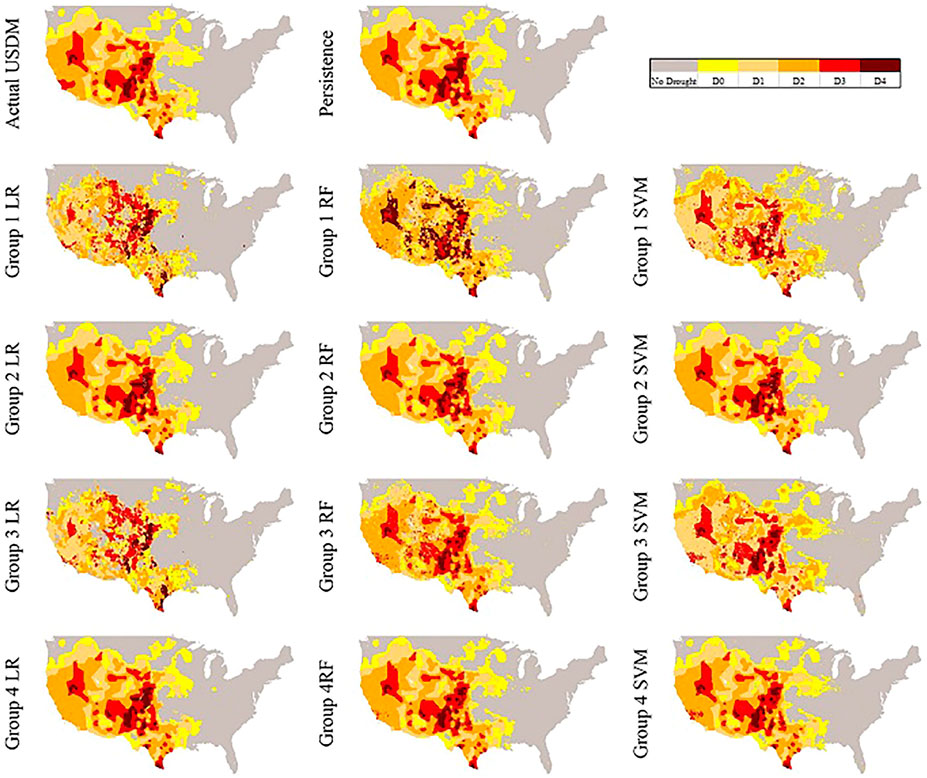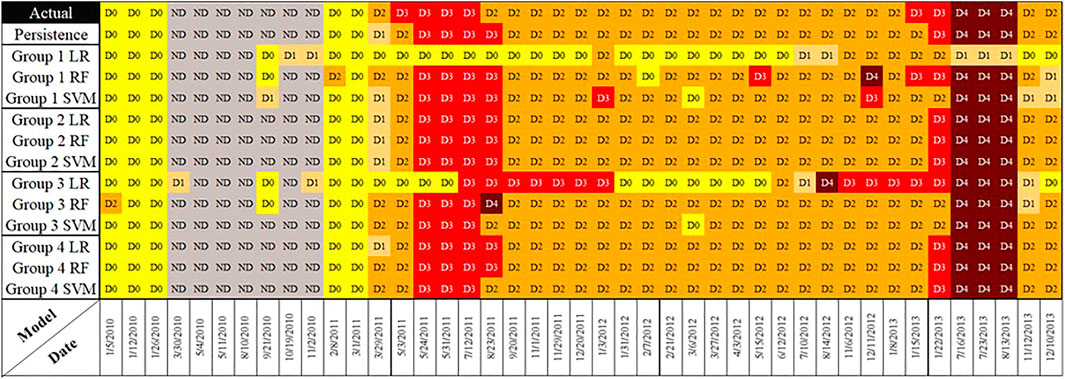- 1Department of Geography, Environment, and Spatial Sciences, College of Social Science, Michigan State University, East Lansing, MI, United States
- 2Department of Computer Science and Engineering, College of Engineering, Michigan State University, East Lansing, MI, United States
The US Drought Monitor (USDM) is a hallmark in real time drought monitoring and assessment as it was developed by multiple agencies to provide an accurate and timely assessment of drought conditions in the US on a weekly basis. The map is built based on multiple physical indicators as well as reported observations from local contributors before human analysts combine the information and produce the drought map using their best judgement. Since human subjectivity is included in the production of the USDM maps, it is not an entirely clear quantitative procedure for other entities to reproduce the maps. In this study, we developed a framework to automatically generate the maps through a machine learning approach by predicting the drought categories across the domain of study. A persistence model served as the baseline model for comparison in the framework. Three machine learning algorithms, logistic regression, random forests, and support vector machines, with four different groups of input data, which formed an overall of 12 different configurations, were used for the prediction of drought categories. Finally, all the configurations were evaluated against the baseline model to select the best performing option. The results showed that our proposed framework could reproduce the drought maps to a near-perfect level with the support vector machines algorithm and the group 4 data. The rest of the findings of this study can be highlighted as: 1) employing the past week drought data as a predictor in the models played an important role in achieving high prediction scores, 2) the nonlinear models, random forest, and support vector machines had a better overall performance compared to the logistic regression models, and 3) with borrowing the neighboring grid cells information, we could compensate the lack of training data in the grid cells with insufficient historical USDM data particularly for extreme and exceptional drought conditions.
Introduction
Drought is a common, periodic and one of the costliest natural disasters that has direct and indirect economic, environmental and social impacts (Wilhite et al., 2007). These impacts become even more serious with the potential increase of drought occurrence and severity caused by climate change (Dai, 2011). A systematic and effective drought monitoring, prediction and planning system is thus crucial for drought mitigations (Boken, 2005). However, as discussed in Hao et al. (2017), drought analysis is not an easy task for a number of reasons. To start with, there is a lack of an explicit and universally accepted definition for drought since it is a multi-faceted phenomenon. Based on the variables in consideration, there are four general types of droughts, namely meteorological, agricultural, hydrological, and socioeconomic drought, for each of which different combinations of drought indices are used to characterize them (Keyantash and Dracup, 2002). Yet, there is no agreement on typical indices and their thresholds for those drought types (M. Hayes et al., 2011) since they do not work for all circumstances (Wilhite, 2000).
Although developing and choosing a proper set of physical drought indices is the basis of drought monitoring to capture the complexity and describe the consequences of drought, a composite index method has been proved to bring more success to the analysis (Hao et al., 2017). The U.S. Drought Monitor (USDM) was developed as the landmark tool in this regard as it not only uses physical drought indices, but also relies on expert’s knowledge in the information interpretation (Anderson et al., 2011). This type of composite drought monitoring, which transforms an abundant set of indicators into a sole product, is called the “hybrid monitoring approach” (M. J. Hayes et al., 2012).
The USDM was established in 1999 aiming at presenting current drought severity magnitude in the categorical means across the U.S. in a weekly map published every Thursday. In the USDM maps, drought is categorized into five categories starting from D0 (abnormally dry), to D1 (moderate drought), D2 (severe drought), D3 (extreme drought), and D4 (exceptional drought). The categories are based on a percentile approach which allows the users to interpret the drought intensity concerning the odds of event occurrence in 100 years (Svoboda, 2000). For example, D0 corresponds to a 20–30% chance for the drought to occur in ranges from 20 to 30 while for D4 it is less than 2%. For observation of the most recent map of the drought condition, refer to droughtmonitor.unl.edu, 2018.
To date, there are six main physical indicators in USDM to define the intensity of the categories: Palmer Drought Severity Index (PDSI) (Palmer, 1965), Climate Prediction Center (CPC) Soil Moisture Model Percentiles, U.S. Geological Survey (USGS) Daily Streamflow Percentiles, Percent of Normal Precipitation and Standardized Precipitation Index (SPI), and remotely sensed Satellite Vegetation Health Index (VT) along with many other supplementary indices such as the Keetch-Bryam Drought Index (KBDI) for fire, Surface Water Supply and snowpack (Svoboda et al., 2002), etc. These indices merged with other in situ data are jointly analyzed by experts to depict the drought categories across the country (M. J. Hayes et al., 2012).
The characteristics of the USDM which makes it a distinct effort in terms of drought monitoring are provided in Table 1. Since the uniqueness of the USDM has made it extremely popular, much attention is drawn to it from media, policy makers and managers (USDA, 2018) as a benchmark in their drought related communications and interpretations. Similarly, researchers have started using the USDM product as a reference observation to compare and validate their proposed drought monitoring and prediction methods (Gu et al., 2007; Brown et al., 2008; Quiring, 2009; Anderson et al., 2011; Anderson et al., 2013; Hao and AghaKouchak, 2014; Otkin et al., 2016; Lorenz et al., 2017a, 2017b). Although it is desirable to predict the USDM drought conditions which are in categorical format, it would not be an easy task due to the subjectivity included in the production process by the experts. A few studies (Hao, et al., 2016a; Hao, et al., 2016b) predicted the monthly average USDM drought categories using ordinal regression by integrating multiple drought indices. However, there has been no previous study using machine learning approaches to predict the USDM drought categories specifically in the original weekly format as the USDM publishes the maps.

TABLE 1. Uniqueness of the US drought monitoring (droughtmonitor.unl.edu, 2019; Svoboda et al., 2002).
In this study, we aim to reproduce the same USDM drought analysis map over conterminous United States (CONUS) based on meteorological observations and land surface model simulated hydrological quantities through a machine learning approach and using multiple drought indicators. We apply linear and nonlinear machine learning approaches using multiple combinations of drought indices against a persistence model serving as the baseline model. The developed framework basically mimics the map synthesizing process executed by the USDM authors. This will not only test the suitability of machine learning methods in drought monitoring and prediction, but also helps us to develop tools that can translate predictions with numerical models to easy-to-understand categorical drought forecasts.
The rest of this paper is organized as follows. Data and Methodology elaborates the study area, data and describes the methodology. Results and Discussion presents the results and discussions. Finally, in the last section we summarize and conclude the findings of this study.
Data and Methodology
In this section the framework of the study to reproduce the USDM drought maps is explained. The process of developing the framework is presented in Figure 1, starting from data preparation including data collection and simulation followed by data preprocessing prior to inputting into the models. Each task is explained in the following sub-sections.
As the drought indices used in our study were derived from land-surface model outputs forced by the North American Land Data Assimilation System phase 2 (NLDAS2)’s meteorological forcing fields, in this study, we deliberately designed our modeling domain to be consistent with the NLDAS2 grids. Thus, the modeling grids span the entire CONUS from 25.0625 to 52.9375° latitude and –67.0625 to –124.9375° longitude, at 1/8º latitude-longitude degree resolution which forms a meshed area with 224 rows and 464 columns (Mitchell et al., 2004).
Data Collection, Simulation, and Preprocessing
To reproduce the USDM maps, a collection of predictor variables, which correspond to drought indices were needed to predict the USDM categories. In the following paragraphs, the process of data collection, simulation, and preprocessing are described. We also explain the rationale behind the selection of each variable and how we obtained, calculated, and resampled the values for each of them prior to modeling.
USDM Data
The USDM weekly drought maps were retrieved from the USDM archived data at https://droughtmonitor.unl.edu/Data/GISData.aspx for the years of 2000 through 2013, starting on January 4 of 2000 and ending on December 31 of 2013, creating a total of 731 weeks of data. The USDM drought maps are vector data that outline the regions in each drought category. As the goal of this study is to reproduce the weekly USDM drought condition across CONUS, each weekly map has to be rasterized to 1/8° NLDAS2 grid. Then for every week, each grid cell is labeled as one of the five USDM drought categories or “No Drought” which makes an overall of six possible states. In the resterization process, any grid cell covering two or more different drought categories is labeled with the drought category which occupied the largest area.
Land Surface Model Outputs and Drought Indices
As the input variables of the actual USDM weekly report vary widely, we selected the frequently used indices in forecasting and monitoring drought. These indices are also the ones that benefit the USDM weekly map production (Anderson et al., 2011). Standardized Precipitation Index (SPI), Standardized Runoff Index (SRI), Soil Moisture Percentile (SMP), and Palmer Drought Severity Index (PDSI) are the employed indices in this study which are summarized in Table 2 and are used as the predictors of the models to predict the USDM drought categories.
SRI and SPI are typically calculated based on monthly data, and can be calculated for up to 72 months historical time periods. In this study, as we try to predict USDM weekly maps, we calculate the SPI and SRI based on daily data (Table 2) at 30-days, 60-days, and 90-day periods. These are the periods that prior to the day of forecast. For convenience, we still call them SPI1, SPI2, and SPI3, just to be consistent with other literature as their time scales are roughly equivalent to 1, 2, and 3 months. In order to create the indices, we first gathered the outputs of both NLDAS-2 Forcing precipitation data and the Land Information System (LIS) models (Noah-3.6, Noah-MP3.6, CLSM-F2.5) runoff and soil moisture from 1979 to 2013. The NLDAS-2 Precipitation, and LIS models hydrological runoff and soil moisture were used to calculate SPI, SRI, and SMP, respectively. It is notable that the calculations of SRI and SMP were based on the average value of three LIS models outputs. SMP values were calculated at the top 1 m for 29-days time window. More specifically, the soil moisture data of 2 weeks backward and onward time window were added to the data of the target day soil moisture to form the data pool for this date in order to compute SMP. Lastly, PDSI data was obtained from Abatzoglou (2019) in 1/24°, which then was projected and resampled to the NLDAS extents. Altogether, throughout the entire domain, every grid cell holds 731 values for each index where each was calculated for the dates that the USDM weekly maps between 2000 and 2013 were published.
Predictors Grouping
Different groups of predictors were used to fit the models so that the impact of different combinations of predictors on the model prediction abilities could be assessed. One of the commonly used terms in this study is the past week USDM drought category or
Toward this purpose, we defined five groups of predictors which are presented in Figure 1. It shows how different combinations of inputs (in color) supply each group of predictors. Group 1 consists the eight drought indices while Group 2 includes the past week USDM drought condition in addition to Group 1 data as one more extra predictor. In contrast to Groups 1 and 2 which solely use the target grid cell information, Groups 3 and 4 include the information of the eight neighboring grid cells as supplementary data. In other words, these Groups of data contains a three by three matrix of grid cells, centered on the target grid cell with nine times more data points. Similar to Group 1, Group 3 includes only the eight drought indices while Group 4 includes the past week USDM data of the grid cells as an additional predictor. Accordingly, one of the five groups of data is imported in the persistence model. This group of data only takes
After grouping the data, standardization of the drought indices values as well as encoding the categorical variable (i.e.,
Modeling
Persistence Model
In machine learning context, generally the performance of an algorithm is compared against a simple and basic method called a baseline model. The performance metric (e.g., accuracy) will then become a benchmark to compare any other machine learning algorithm against. In this study a persistence model plays the role as the baseline model. We define a persistence model as a model which assumes the current week drought condition persists in next week. In other words, the model predicts the USDM drought category of an area for a specific week as its past week drought category. In this study, the rationale for using a persistence model as the baseline model is the slow-moving nature of drought, hence the probability of a drought (or wetness) condition persisting in the next weeks could have a relatively high likelihood. Obviously, the persistence modeling for the areas with more weekly variation in drought category is subject to more prediction error. Figure 1 shows how the corresponding input data is being carried over to the persistence model.
Machine Learning Models
Prediction of the USDM categories is an ordinal classification problem, as it is a forced choice for the models to predict six discrete responses, No Drought, D0, D1, D2, D3, and D4. Toward this purpose, three machine learning algorithms, logistic regression, random forest classifier, and support vector machines (SVM) are selected to be examined for classification prediction.
The logistic regression model is used as a linear classification algorithm which uses the sigmoid function to limit the output of a linear equation between 0 and 1 as the probability outcome of the default class (Hosmer Jr et al., 2013). The estimation of the algorithm coefficient must be done on training data using maximum likelihood. Logistic regression is a widely used classification technique due it its computational efficiency and being easily interpretable.
Random Forest (Ho, 1995) have successfully been implemented in various classification problems (banking, image classification, stock market, medicine, and ecology) and is one the most accurate classification algorithms that works well with large datasets. The Random Forest classifier is a nonlinear classifier which consists an ensemble of decision tree classifiers. Each classifier is generated by a random set of features sampled independently from the input features, and each tree deposits a unit vote for the most suitable class to classify an input vector (Breiman, 2001). There are not many hyperparameters and they are easy to understand. Although, one of the major challenges in machine learning is overfitting, but the majority of the time this will not occur to a Random Forest classifier if there are sufficient trees in the forest and the hyperparameters, particularly the maximum depth of trees is tuned.
SVM are broadly used as a classification tool in a variety of areas. They aim to determine the position of decision boundaries that produce the most optimum class separation (Cristianini and Shawe-Taylor, 2000). In classification, a maximal margin hyper-plane separates a specified set of binary labeled training data. However, if there is no possible linear features separation, SVM employ the techniques of kernels to make them linearly separable after they are mapped to a high dimensional feature space. The two standard kernel choices are polynomial and Radial Basis Function (RBF). In this study, we use an RBF kernel in SVM classifiers since RBF kernel is more capable compared to polynomial in representing the complex relationships in data especially the synergic complexities associated with growing data.
5-Fold Cross-Validation
With the use of each machine learning algorithm and group of input variables, for each grid cell in the domain we build its own specific models. In all the three modeling algorithms, choosing the optimal learning parameter(s) of the models known as “hyperparameter tuning” was performed by splitting the data to 80% training and 20% testing and executing 5-fold cross-validation on the training to select the best model. The logistic regression has only one hyperparameter, C with an
Metric of Performance Assessment
In this study,
when a larger
Results and Discussion
Our introductory analysis to the data was to explore the spread of different drought conditions across the domain during the 731 weeks. By utilizing the outcome, we can better perceive the contribution associated to the number of data points with the models prediction performance. Out of 103,936 grid cells within the domain, 51,997 grid cells never experienced any USDM drought condition during the 14 years of data which means they were always labeled as No Drought or were not in the USDM weekly maps CONUS domain. The remaining 51,939 grid cells have experienced both D0 and D1 drought categories at least once during that time period. Therefore, in our classification task, there were at least three different classes, No Drought, D0 and D1 which are to be predicted. However, for the grid cells experiencing more of the drought conditions other than D0 and D1, the prediction is a multi-class classification task of four or more classes. During 731 weeks of the USDM data, there were 50,546 grid cells experiencing D2 (as well as No Drought, D0, and D1), 44,203 grid cells experiencing D3 (in addition to No Drought, D0, D1, and D2) and 24,210 grid cells experiencing D4 (along with No Drought, D0, D1, D2, and D3) at least once. Figure 3 presents the histograms of each drought category throughout the entire domain. The included grid cells in the histograms are out of those 51,939 which have experienced more than one type of USDM drought condition. From the histograms we can observe as the drought conditions become more severe (from No Drought to D4), the grid cell mean count of the categories decrease from 369.51 for No Drought down to 25.01 for D4.
Persistence Model
As we discussed earlier, the group of data which solely contained the
The results in Table 3 show that the persistence model prediction score for all the classes and the weighted average is relatively high. This is basically an endorsement for the slow-moving nature of drought so that a persistence model achieves such high scores at all levels.
The persistence model performs worse in the areas with more drought weekly fluctuations since an alteration in the drought condition from the current week to the next corresponds to one prediction error for the model. Furthermore, the standard deviation of the accuracies from No Drought to D4 constantly increases, yet the Weighted Average standard deviation (in Table 4) stays as small as 0.03 because of the larger weights of the less severe drought conditions in contrast to D3 and D4 categories.

TABLE 4. Descriptive statistics of the models performances using Group 1 input features over the entire domain.
The spatial distribution of the grid cells weekly fluctuation is presented in Figure 4 (upper panel) showing the lowest variation between the USDM drought categories during 731 weeks of data is 23, while the largest is 136. As we can see, the highest weekly fluctuations are located in Southeast and Plains areas where the climate is warm temperature, humid with hot summers (Kottek et al., 2006). The lower panel in Figure 4, on the other hand, displays the persistence model weighted average
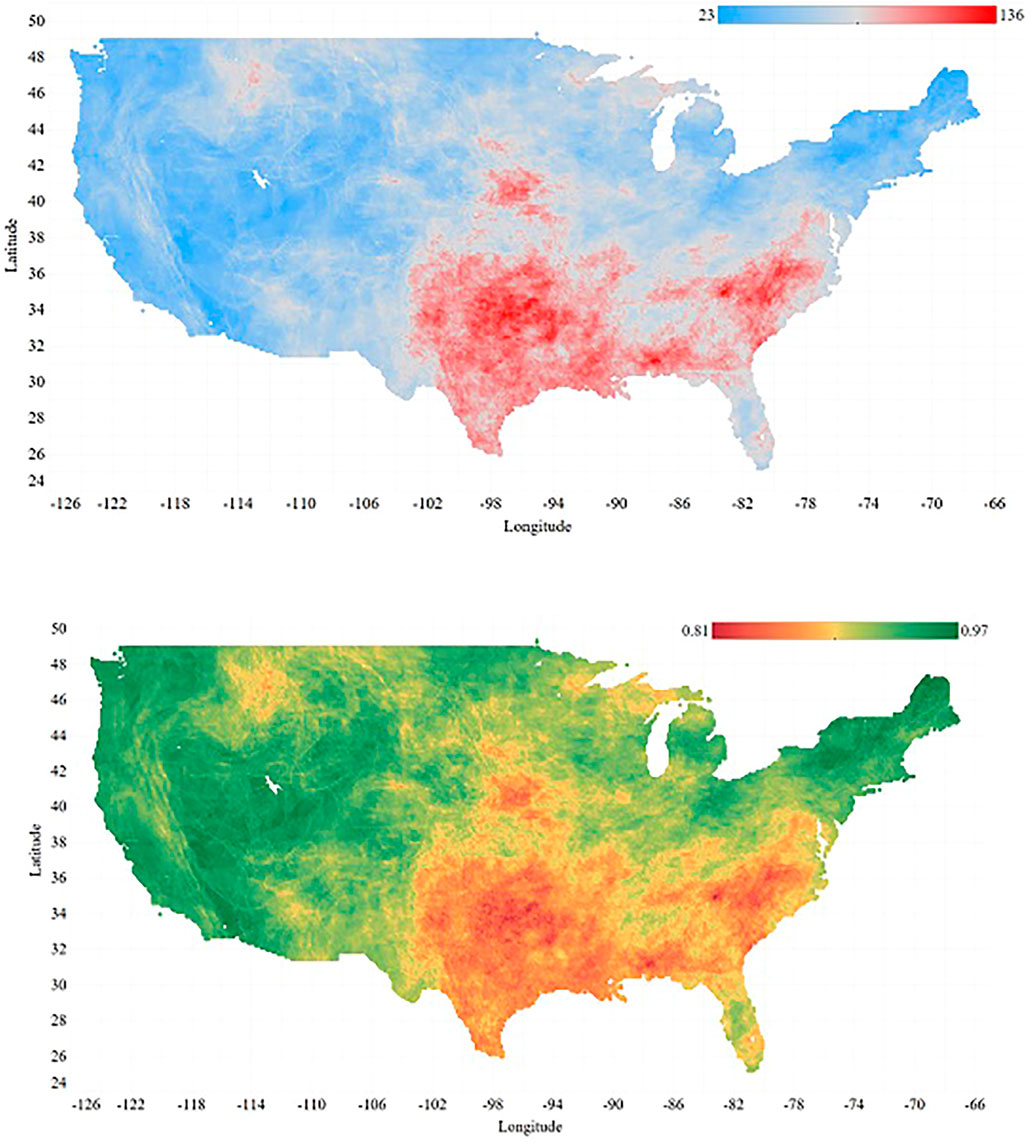
FIGURE 4. Upper Panel: Spatial presentation of the number of weekly fluctuations for each grid cell during 731 weeks (the number of changes in drought condition during 731 weeks)–Lower Panel: Spatial distribution of the persistence model weighted average F1 Score across the domain of study.
Machine Learning Models
Results for Using Group 1
In this section, we present and discuss the results of the logistic regression, Random Forest and SVM using four different Groups of input data. Table 4 contains the summary of the obtained scores for entire domain by three models by running on the Group 1 data. As we can see, the nonlinear models (i.e., Random Forest and SVM) substantially perform better than the linear model (i.e., logistic regression), while the highest scores as well as the average score are obtained by SVM for all the drought categories. However, none of the models can reach the scores that were obtained by the persistence model by any means, neither for any of the six drought classes, nor on average. Moreover, the scores standard deviations of all three models are more than the baseline model so the prediction accuracies are also less consistent.
Results for Using Group 2
The results of the modeling with the Group 2 data set are presented in Table 5. All three models especially the logistic regression demonstrate a great improvement over the Group 1 input feature just by adding

TABLE 5. Descriptive statistics of the models performances uing Group 2 input features over the entire domain.
During the model training with Group 1 and 2 data, the range of the
With the use of Group 2 data in the modeling, on average in 31,732 grid cells (61% of the domain) logistic regression performed better than or equal to the persistence model. This is the case for the Random Forest model in 27,139 grid cells (52% of the domain) and in 31,085 grid cells (60% of the domain) for the SVMs. Adding the past week information to the data, helped the models to improve their prediction accuracy, however, it was still challenging to be assertive about outperforming the baseline model. With the presumption that lack of data point may be the cause of underperformance, we tried the Groups 3 and 4 in the models so that we could possibly find out whether there would be any improvement in prediction accuracy.
Results for Using Group 3
The performance of the machine learning models without

TABLE 6. Descriptive statistics of the models performances using Group 3 input features over the entire domain.
The weighted average accuracy of the logistic regression dropped significantly once again when the past week information predictor was eliminated. Despite the importance of the eliminated predictor, the nonlinear models, Random Forest and SVM could sustain fairly close to the persistence model on average but still lower, with 0.87 and 0.90
When compared the weighted average
Results for Using Group 4
The results of using Group 4 dataset in the modeling are presented in Table 7. Compared to the Groups 1, 2, and 3 results, there is a noticeable improvement in

TABLE 7. Descriptive statistics of the models performances using Group 4 input features over the entire domain.
By looking into the one by one obtained
Side-By-Side Boxplot Comparison of the Model Performance Using Different Groups of Data
In this section, we present and discuss the performances of all the 13 different types of modeling in this study, next to each other in the format of boxplots. Figure 5 provides a side-by-side overall performance of the models (i.e., weighted average) as well as the results of the models for each USDM category. In the boxplots, the box middle line, bottom line and top line are the median, 25th percentile and 75th percentile, respectively. The whiskers extend 1.5 times the height of the box (Interquartile range or IQR), and the points are extreme outliers which are three times greater than the IQR. From the Figure Weighted Average panel, we could clearly find out that the USDM drought labels were better predicted by the nonlinear functions in terms of accuracy and deviation. The linear model fulfilled a meaningfully better prediction with the presence of the
In terms of feature importance in the models, both the logistic regression and random forest commonly recognized PDSI as the most important predictor in Group 1 and Group 3, while in Groups 2 and 4,
Visual Comparison of the Models Over CONUS
For a better illustration in comparing the reproduced maps by the models and the actual USDM map, we also selected two random dates. In Figure 6, the actual USDM map is not experiencing any D4 but two spots of D3 in Midwest and Northwest regions. Figure 7, however, shows larger and more scattered areas of D3 and D4 across the domain.
In Figure 6, the persistence model can closely catch D3 areas however, it does not perform well in predicting the D0, D1, and D2 while the large areas of D0 are replaced with D1 and D2. This is possibly due to precipitations during the past week generated map date (9/27/2005) and the date of this map (April 10, 2005) in which has made those areas drought severity one category less extreme. The generated maps from Groups 1 and 3 models do not look well reproduced except Group 3 RF and SVM, however, both still are not as smooth as expected. The entire Group 2 map plus Group 4 LR are very similar to the persistence model map which means the models are heavily relying on the
Figure 7 has a relatively similar persistence model to the actual USDM map except a few small areas such as not being able to recognize an D3 area in California and replacing a No Drought region in Indiana with D0. As it can be seen, the models in Groups 1 are not doing well, however, there is a significant improvement once the models are fed with
As the last step, in order to show a more in detail models comparison instead of the overall average performance, we selected a random sample grid cell located at the latitude of 35.0630, and longitude–105.3130 (appeared to be in New Mexico) and put the test data from the years 2010–2013 in a time series graph. Figure 8 presents the actual test data into the models and each model prediction. It is notable that the graph is an ordered time series of the test data points, but the dates are not consecutive due to random selection of training and test set, while the weeks in between were used as training data for the models. Similar to the above generated maps, here the Group 2 models are significantly relying on the
Conclusion
Our proposed framework successfully reproduced the USDM drought categories using multiple drought indices and machine learning algorithms that are logistic regression, Random Forest and SVM. The framework was compared to a persistence model as the baseline model in which it was assumed that current week drought condition would persist in next week. As this study was a classification task, the machine learning models were evaluated by their overall prediction scores as well as each class prediction score. Although, in terms of prediction accuracy, there was not much room left for improvement by the baseline model, our proposed framework could outperform it by testing different scenarios of the data inputs and machine learning algorithms to find the best combination.
We found out that employing the past week drought data as a predictor in the models played an important role in achieving high prediction scores especially for the logistic regression. The nonlinear models, Random Forest, and SVM suffered less without the use of that predictor in terms of prediction score. Furthermore, taking the neighboring grid cells information into account, could compensate the lack of data points for training the models. It was essentially a spatially compensation of the USDM data due to temporal shortage (731 weeks). Training the models faced the lack of data problem particularly for the categories D3 and D4. In some grid cells when the number of D3 and D4 were smaller than the number of the folds in cross validation (i.e., 5 in this study) as well as random selection of training and test splits, technically some folds could not contain those categories during the learning process which resulted in poor predictive skill.
Future works could be the examination of a multi-task learning approach which works well with limited data by leveraging information from nearby locations. Also, since we have been successful in being close to mimicking the USDM experts drought categories synthesizing, this methodology could be used in an automated system in generating the weekly maps. The system would be using LSMs to produces the outputs which are needed to calculate the drought indices which represent meteorological, agricultural, and hydrologic drought. Thereafter by creating the indices for the target day that the map is going to be published and using the past week drought condition as another variable, the SVM model as the best performing model in this study would predict the drought conditions across the entire United States.
Data Availability Statement
The raw data supporting the conclusions of this article will be made available by the authors, without undue reservation.
Author Contributions
The research in this article was primarily fulfilled and written by PH, while supervised, funded, and edited by professors LL and PT. LP contributed by calculating the drought indices from the land surface model outputs, in addition to revising the article.
Funding
This research was primarily supported by the National Science Foundation through grants NSF-1615612 and NSF-2006633, and NOAA grant NA17OAR4310132.
Conflict of Interest
The authors declare that the research was conducted in the absence of any commercial or financial relationships that could be construed as a potential conflict of interest.
Publisher’s Note
All claims expressed in this article are solely those of the authors and do not necessarily represent those of their affiliated organizations, or those of the publisher, the editors and the reviewers. Any product that may be evaluated in this article, or claim that may be made by its manufacturer, is not guaranteed or endorsed by the publisher.
References
Abatzoglou, J. T. (2019). GRIDMET. Retrieved from http://www.climatologylab.org/gridmet.html.
Anderson, M. C., Hain, C., Otkin, J., Zhan, X., Mo, K., Svoboda, M., et al. (2013). An Intercomparison of Drought Indicators Based on Thermal Remote Sensing and NLDAS-2 Simulations with U.S. Drought Monitor Classifications. J. Hydrometeorology 14 (4), 1035–1056. doi:10.1175/jhm-d-12-0140.1
Anderson, M. C., Hain, C., Wardlow, B., Pimstein, A., Mecikalski, J. R., and Kustas, W. P. (2011). Evaluation of drought indices based on thermal remote sensing of evapotranspiration over the continental United States. J. Clim. 24 (8), 2025–2044. doi:10.1175/2010jcli3812.1
Boken, V. K. (2005). Agricultural drought and its monitoring and prediction: some concepts. Monit. predicting Agric. drought: A Glob. Study, 3–10.
Brown, J. F., Wardlow, B. D., Tadesse, T., Hayes, M. J., and Reed, B. C. (2008). The Vegetation Drought Response Index (VegDRI): A new integrated approach for monitoring drought stress in vegetation. GIScience & Remote Sensing 45 (1), 16–46. doi:10.2747/1548-1603.45.1.16
Cristianini, N., and Shawe-Taylor, J. (2000). An Introduction to support vector machines and other kernel-based learning methods. Cambridge: Cambridge University Press.
Dai, A. (2011). Drought under global warming: a review. Wires Clim. Change 2 (1), 45–65. doi:10.1002/wcc.81
droughtmonitor.unl.edu (2018). .USDM Map August 7, 2018. Retrieved from https://droughtmonitor.unl.edu/.
droughtmonitor.unl.edu (2019). What is the USDM. Retrieved from https://droughtmonitor.unl.edu/AboutUSDM/WhatIsTheUSDM.aspx.
Goutte, C., and Gaussier, E. (2005). A probabilistic interpretation of precision, recall and F-score, with implication for evaluation. Paper presented at the European Conference on Information Retrieval.doi:10.1007/978-3-540-31865-1_25
Gu, Y., Brown, J. F., Verdin, J. P., and Wardlow, B. (2007). A five‐year analysis of MODIS NDVI and NDWI for grassland drought assessment over the central Great Plains of the United States. Geophys. Res. Lett. 34, 6. doi:10.1029/2006gl029127
Hao, Z., and AghaKouchak, A. (2014). A nonparametric multivariate multi-index drought monitoring framework. J. Hydrometeorology 15 (1), 89–101. doi:10.1175/jhm-d-12-0160.1
Hao, Z., Hao, F., Xia, Y., Singh, V. P., Hong, Y., Shen, X., et al. (2016a). A statistical method for categorical drought prediction based on NLDAS-2. J. Appl. Meteorology Climatology 55 (4), 1049–1061. doi:10.1175/jamc-d-15-0200.1
Hao, Z., Hong, Y., Xia, Y., Singh, V. P., Hao, F., and Cheng, H. (2016b). Probabilistic drought characterization in the categorical form using ordinal regression. J. Hydrol. 535, 331–339. doi:10.1016/j.jhydrol.2016.01.074
Hao, Z., Yuan, X., Xia, Y., Hao, F., and Singh, V. P. (2017). An overview of drought monitoring and prediction systems at regional and global scales. Bull. Am. Meteorol. Soc. 98 (9), 1879–1896. doi:10.1175/bams-d-15-00149.1
Hayes, M. J., Svoboda, M. D., Wardlow, B. D., Anderson, M. C., and Kogan, F. (2012). Drought Monitoring: Historical and Current Perspectives Drought Mitigation Center Faculty Publications, 92. http://digitalcommons.unl.edu/droughtfacpub/94.
Hayes, M., Svoboda, M., Wall, N., and Widhalm, M. (2011). The Lincoln declaration on drought indices: universal meteorological drought index recommended. Bull. Am. Meteorol. Soc. 92 (4), 485–488. doi:10.1175/2010bams3103.1
Ho, T. K. (1995). “Random decision forests,” in Paper Presented at the Proceedings of 3rd International Conference on Document Analysis and Recognition IEEE.
Hosmer, D. W., Lemeshow, S., and Sturdivant, R. X. (2013). Applied logistic regression, Vol. 398. New Jersey: John Wiley & Sons.
Keyantash, J., and Dracup, J. A. (2002). The quantification of drought: an evaluation of drought indices. Bull. Amer. Meteorol. Soc. 83 (8), 1167–1180. doi:10.1175/1520-0477-83.8.1167
Kottek, M., Grieser, J., Beck, C., Rudolf, B., and Rubel, F. (2006). World Map of the Köppen-Geiger climate classification updated. metz 15 (3), 259–263. doi:10.1127/0941-2948/2006/0130
Lorenz, D. J., Otkin, J. A., Svoboda, M., Hain, C. R., Anderson, M. C., and Zhong, Y. (2017a). Predicting the U.S. Drought Monitor Using Precipitation, Soil Moisture, and Evapotranspiration Anomalies. Part II: Intraseasonal Drought Intensification Forecasts. J. Hydrometeorology 18 (7), 1963–1982. doi:10.1175/jhm-d-16-0067.1
Lorenz, D. J., Otkin, J. A., Svoboda, M., Hain, C. R., Anderson, M. C., and Zhong, Y. (2017b). Predicting U.S. Drought Monitor States Using Precipitation, Soil Moisture, and Evapotranspiration Anomalies. Part I: Development of a Nondiscrete USDM Index. J. Hydrometeorology 18 (7), 1943–1962. doi:10.1175/jhm-d-16-0066.1
McKee, T. B., Doesken, N. J., and Kleist, J. (1993). “The relationship of drought frequency and duration to time scales,” in Paper presented at the Proceedings of the 8th Conference on Applied Climatology.
Mitchell, K. E., Lohmann, D., Houser, P. R., Wood, E. F., Schaake, J. C., Robock, A., et al. (2004). The multi‐institution North American Land Data Assimilation System (NLDAS): Utilizing multiple GCIP products and partners in a continental distributed hydrological modeling system. J. Geophys. Res. Atmospheres 109, D7. doi:10.1029/2003jd003823
Otkin, J. A., Anderson, M. C., Hain, C., Svoboda, M., Johnson, D., Mueller, R., et al. (2016). Assessing the evolution of soil moisture and vegetation conditions during the 2012 United States flash drought. Agric. For. Meteorology 218-219, 230–242. doi:10.1016/j.agrformet.2015.12.065
Palmer, W. (1965). Meteorological drought. US Weather Bureau Research Paper, 45. Washington DC: Office of Climatology, US Department of Commerce, 58.
Quiring, S. M. (2009). Developing objective operational definitions for monitoring drought. J. Appl. Meteorology Climatology 48 (6), 1217–1229. doi:10.1175/2009jamc2088.1
Sheffield, J., Goteti, G., Wen, F., and Wood, E. F. (2004). A simulated soil moisture based drought analysis for the United States. J. Geophys. Res. Atmospheres 109, D24. doi:10.1029/2004jd005182
Shukla, S., and Wood, A. W. (2008). Use of a standardized runoff index for characterizing hydrologic drought. Geophys. Res. Lett. 35 (2). doi:10.1029/2007gl032487
Svoboda, M., LeComte, D., Hayes, M., Heim, R., Gleason, K., Angel, J., et al. (2002). The drought monitor. Bull. Amer. Meteorol. Soc. 83 (8), 1181–1190. doi:10.1175/1520-0477-83.8.1181
USDA (2018). The U.S. Drought Monitor: A Resource for Farmers, Ranchers and Foresters. Retrieved from https://www.usda.gov/media/blog/2018/04/19/us-drought-monitor-resource-farmers-ranchers-and-foresters.
Wilhite, D. A. (2000). Chapter 1 Drought as a Natural Hazard: Concepts and Definitions Drought Mitigation Center Faculty Publications, 69. http://digitalcommons.unl.edu/droughtfacpub/69.
Keywords: USDM, machine learning, drought monitoring, logistic regression, random forest, SVM–support vector machines, drought indices
Citation: Hatami Bahman Beiglou P, Luo L, Tan P-N and Pei L (2021) Automated Analysis of the US Drought Monitor Maps With Machine Learning and Multiple Drought Indicators. Front. Big Data 4:750536. doi: 10.3389/fdata.2021.750536
Received: 30 July 2021; Accepted: 08 October 2021;
Published: 25 October 2021.
Edited by:
Huan Wu, Sun Yat-sen University, ChinaReviewed by:
Jianmin Wang, South Dakota State University, United StatesFeng Tian, Wuhan University, China
Copyright © 2021 Hatami Bahman Beiglou, Luo, Tan and Pei. This is an open-access article distributed under the terms of the Creative Commons Attribution License (CC BY). The use, distribution or reproduction in other forums is permitted, provided the original author(s) and the copyright owner(s) are credited and that the original publication in this journal is cited, in accordance with accepted academic practice. No use, distribution or reproduction is permitted which does not comply with these terms.
*Correspondence: Lifeng Luo, bGx1b0Btc3UuZWR1
 Pouyan Hatami Bahman Beiglou
Pouyan Hatami Bahman Beiglou Lifeng Luo
Lifeng Luo Pang-Ning Tan
Pang-Ning Tan Lisi Pei
Lisi Pei